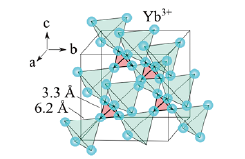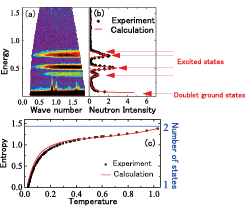Novel Quantum State in a Breathing Pyrochlore Antiferromagnet
Masuda Group
In geometrically frustrated magnet, a macroscopic degeneracy remains even at zero temperature as long as the geometry is preserved. Such a situation contradicts the third law of thermodynamics and small perturbations, which can induce non-trivial quantum states, play an important role in avoiding the breakdown of the basic law. A classic example of the violation of the third law is given by a regular tetrahedron of S = 1/2 Heisenberg spins; this has a nonmagnetic ground state with a two-fold degeneracy. In nature, however, neither perfect isolation nor absence of coupling to other degrees of freedom is achieved and a non-degenerate state is induced by a perturbation. The search for a simple and isolated system is a challenge to the third law, leading to discovery of new state of matter at very low temperatures. Ba3Yb2Zn5O11 is a rare experimental realization of non-distorted regular tetrahedron spin system as shown in Fig. 1. Magnetic Yb3+ ions form breathing pyrochlore lattice, and no phase transition was reported at T > 0.38 K [1]. Crystal field excitation measured by using HRC spectrometer in the energy range of ħω < 150 meV exhibited that the Yb3+ ion is regarded as an effective spin S = 1/2 with small easy-plane anisotropy [2]. We, then, study low energy excitations to identify the ground state of the spin tetrahedra in the real world [3].

Fig. 1. Crystal structure of Ba3Yb2Zn5O11. Regular tetrahedra of Yb3+ ions form breathing pyrochlore lattice.

Fig. 2. Neutron spectrum and entropy change of Ba3Yb2Zn5O11. (a) Spectrum measured at 1.5 K. (b) Neutron intensity of the experiment and that of the calculation of the spin tetrahedron model (see the text in detail). (c) Entropy change. Selection of the ground state is observed.
The INS spectrum at the base temperature in Fig. 2(a) shows four flat peaks; the excitations are sharp and the system is regarded as isolated. The spectrum is reproduced by the spin tetrahedron model with Jx = -0.57 meV, Jz = -0.56 meV, JDM = 0.11 meV as shown in Fig. 2(b), and the system includes large Dzyaloshinskii-Moriya (DM) interaction. The DM interaction hybridizes the ground state with the excited ones, leading to the change of selection rule of INS spectrum, but it does not lift the two-fold degeneracy of the ground state in the isolated spin tetrahedron. To observe the real ground state, we measured heat capacity down to very low temperature and estimated the change of the entropy. As shown in Fig. 2(c) the entropy gradually decreases with the temperature and reaches almost zero, meaning that a unique ground state is selected. Nature, thus, realizes a novel spin liquid state thorough a perturbative term. As a candidate state, a spin liquid having partial dimer order or chiral order is theoretically predicted in weakly coupled spin tetrahedra. For the further understanding ultra-high-resolution INS experiment at ultra-low temperature is important.
References
- [1] K. Kimura et al., Phys. Rev. B 90, 060414(R) (2014).
- [2] T. Haku et al., J. Phys. Soc. Jpn. 85, 034721 (2016). The spectra of the crystal electric field is described in the section of the progress of neutron facility in this activity report.
- [3] T. Haku et al., Phys. Rev. B 93, 220407(R) (2016). The INS experiment was performed at PELICAN spectrometer installed in ANSTO. The travel expenses for the experiment were supported by General User Program for Neutron Scattering Experiments, Institute for Solid State Physics, the University of Tokyo (proposal No. 15543).
